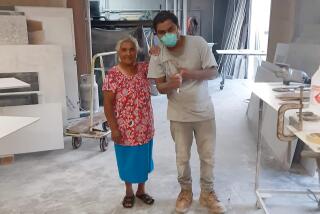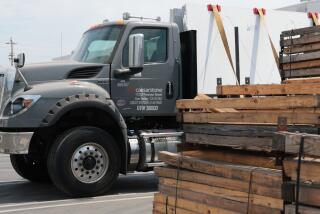Hard Choices Among Counter Tops
In this age of high-priced construction, counter tops are getting as hard to choose as plumbing fixtures or light fixtures. There are the solid-surface materials such as Corian, Gibralter and Avonite. There are plastic laminates from Formica to Wilsonart. And don’t forget ceramic tile, porcelain tile, slab and tile granite, concrete, slab and tile marble. And what about stone? How easy it is to become confused by all that’s available.
In a kitchen, the counter top has as much to do with the overall appearance as the cabinets do.
In order of cost, we will class counter tops into six basic categories, with the three in most common use listed first (laminates, tile and synthetic solid-surface products):
* Plastic laminate counter tops
Plastic laminate has been around since the beginning of modern kitchens. Several layers of resin-coated paper are sandwiched together (and held under heat and pressure) to form what we think of as Formica. Plastic laminate tops come in many colors and textures. The latest rage is having your plastic laminate custom-designed to your own color, texture and style, but be prepared to spend some money here. With standard plastic laminate tops, the color is in the final layer. When it is applied at corners, you see the resin-coated layers of paper as a black line. With higher quality plastic laminate all layers of the material are colored--not just the final one. When this material is applied to a corner there is no black line. An entire laminate counter can be installed for $600 to $1,800 for most kitchens.
* Ceramic and porcelain tile
There is no limit to what you can do with ceramic tile. Inlaid with real gold, burnished for texture and hand-painted finishes are just a few of the choices. The problem here is grout lines. No one seems to want to deal with grout cleaning any more. Tile grout does require regular maintenance. Sealing the grout only means that cleaning will be easier to do. So far we haven’t heard any complaints about tile except that the surface begins to dull after about 40 years if abrasive cleaners are constantly used. Porcelain is harder than a rock and far more durable than conventional ceramic tile. It also is more expensive. Fewer color choices are available in porcelain. Ceramic tile and porcelain are more than twice the price of plastic laminates.
* Solid-surface counter tops
New synthetic solid-surface counter tops are growing in popularity. The grout cleaning and maintenance problem disappears with solid-surface materials. We consider all of these products a good bet. Each manufacturer has its own series of colors. Although Dupont’s entry, Corian, can be sanded if burned or gouged, it remains a surface somewhat susceptible to scratching and similar damage. Other brands are harder, but cannot be repaired on the spot by a novice. Bottom line--if you decide on any of the solid-surface products, be sure to take it easy. You will be trading off grout cleaning for a surface that is less durable than tile. Solid-surface counter top prices begin where tile prices leave off. Here, the sky is the limit.
* Marble, granite and stone tile
Marble, granite and stone tiles are for those who would prefer them in slab form. The neat thing about these tiles is that the grout line can be extremely thin. This reduces the need for extensive grout cleaning, but does not eliminate the chore. Most marble is susceptible to damage from citric acid and alcohol. Vinegar is another mild acid that will quickly remove the shine from most polished marble surfaces. In a few seconds the surface can be devastated. The same is true for many polished stone surfaces. Marble and granite tiles are about the same price as the solid-surface products.
Tip: If you want to test stone to ensure that it won’t fail as a counter top, lay a sample in the kitchen sink and pour vinegar onto the polished surface. If the shiny surface dulls, you know what will happen when it becomes a counter top.
Granite is the best of the stone tiles. It is the hardest and is impervious to just about anything. Unfortunately, because all of these products are natural, you are limited to what Mother Nature has to offer. We think that granite tiles give ceramic tile a real run for the money when it comes to elegance.
* Concrete slab (poured in place)
We don’t see a lot of concrete being poured on kitchen counters (inside the home at least), but they are gaining in popularity. Concrete counter tops are expensive, require a sealant and must be treated with care. Prices for concrete tops are all over the board. Expect to pay through the nose.
* Slab marble or granite
Slab marble has the same problems as marble tiles. Alcohol and mild acids are bad medicine. Tile or slab must be handled with kid gloves. Many types of hair spray contain alcohol. Granite, on the other hand, is extremely hard, incredibly durable and maintenance-free. Our experience is that slab granite is the single most maintenance-free surface. You can expect to pay as much as $200 per square foot for certain colors of slab granite.
The good news is, that with its sudden popularity, granite is getting cheaper and easier to buy. Today the big box stores are offering granite installed for $70 per square foot. Expensive yes, but better than the $100-plus we’ve been seeing. We recently spoke with a fellow named Steve Neal, owner of Straight Line Importers in Martinez, Calif., who is part of a small new group of stone contractors selling prefabricated 8-foot long counters--ready to install--for $30 to $50 per square foot (depending on the color). That’s less than the cost of most popular synthetic solid-surface materials. Neal says colors are limited to five now, but 12 will be available soon.


